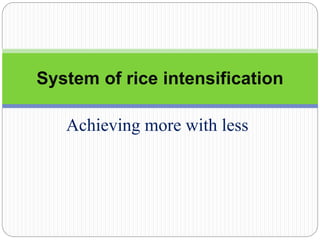
Achieving More with Less - SRI for Higher Rice Yields
- 1. Achieving more with less System of rice intensification
- 2. What is SRI? An agro-ecological methodology for increasing the productivity of irrigated rice by changing the management of plants, soil, water and nutrients. More output from less input The System of Rice Intensification involves cultivating rice with as much organic manure as possible, starting with young seedlings planted singly at wider spacing in a square pattern; and with intermittent irrigation that keeps the soil moist but not inundated, and frequent weeding that actively aerates the soil.
- 3. The main concepts, ideas and principles of SRI Stimulating plant growth by: Transplanting young seedlings to preserve growth potential Avoid disturbance to the roots - transplant quickly and shallow, not inverting root tips Provide plants wider spacing - one plant per hill and in square pattern
- 4. Enhance the growth and health of roots and of soil Biota by: Keeping soil moist but not flooded - soil should be mostly aerobic, not continuously saturated Aerating the soil frequently by weeding frequently Enhancing the soil organic matter content by the addition of organic manure
- 5. History of SRI Put into practice in the early 1980s by French Jesuit priest and agronomist Henri de Laulanié After many years of observation in field trials with small-scale farmers in Madagascar, he came up with the System of Rice Intensification (SRI); a system that requires less Today it is one of the most rapidly growing rice cultivation practices.
- 7. Breaking the rice myths We have been led to believe that rice is an aquatic plant and grows best in standing water. But rice is not an aquatic plant; it can survive in water but does not thrive under reduced oxygen (hypoxic) levels. Rice plants spend lot of its energy to develop air pockets (aerenchyma tissue) in its roots under continuous inundation. Nearly 70% of rice root tips get degenerated by flowering period.
- 8. SRI : debunking the myths The SRI rice fields are not flooded but kept moist during the vegetative phase. Later about 1 inch of water is maintained. SRI requires only about half as much water as normally applied in irrigated rice. Without the traditional flooded rice condition, rice yield is increased from 20-100%
- 9. Comparison between conventional and SRI method Particulars Conventional method SRI Spacing 15*10cm 25*25cm No. of plants per sq. m 66 16 No. of seedlings per hill 3 1 No. of plants per acre 792000 64000 Seed requirement per acre 20kg 2kg However SRI is initially labor intensive as it needs 50% more man-days for transplanting and weeding.
- 10. SRI allows plant to grow healthy by: Large root volume Profuse and strong tillers - Maximum tillering (30 tillers/plant can be easily achieved; 50 tillers per plant are quite attainable). Under excellent management even 100 fertile tillers per plant or even more can be achieved due to early transplanting and absence of die back of roots. Non lodging Big panicles More and well filled grain panicles and higher grain weight Resists insects because it allows rice to absorb soil nutrients naturally
- 11. Method:
- 12. Land preparation Land preparation is not different from regular irrigated rice cultivation. Leveling should be done carefully so that water can be applied very evenly.
- 13. Seedling preparation Seed rate 2 kg/acre Select healthy seeds Apply a layer of fine manure Spread seed sparsely Cover with another layer of manure Mulch with paddy straw Water carefully
- 14. Transplanting 8-12 days old seedlings are transplanted Care should be taken during pulling out and transplanting of seedlings Seedlings are transplanted shallow and therefore establish quickly. Spacing is 25*25cm So, seedlings do not compete for nutrients, space and sun, and develop stronger roots and more tillers.
- 15. Water application Instead of continuously flooding fields, plants only receive the ideal amount of water and the soil is temporarily kept dry. This favors soil microbial development and reduces methane emissions. The purpose of irrigation is just to wet the soil, just enough to saturate the soil with moisture Subsequent irrigation is only when soil develops fine cracks. Regular wetting and drying of soil results in increased microbial activity in the soil and easy availability of nutrients to the plants.
- 16. Weed management Absence of standing water leads to more weed growth in SRI. Incorporate the weeds in the soil by moving the weeder between the rows Weeds close to the hills/tillers have to be removed by hand Since weed has to be controlled manually using a mechanical hand tool, the soil is well aerated, thereby improving plant growth.
- 17. Organic fertilization Organic manure and compost is used for fertilization Compost / FYM applied instead of or in addition to chemical fertilizer
- 18. Advantages Increase in yield/ha – 52% (21 to 105%) Increased net income/ha – 128% (59 – 412% ) Reduction in cost of production – 24% (7 – 56%) Reduction in water requirement – 44% (24 – 60%) Shorter time to maturity (1-3 weeks less) Protection against biotic stresses pests/diseases (Sheath blight, leaf folder, brown plant hopper) – 70% reduction in incidence Tolerant to abiotic stresses - drought, storm damage, extreme temperatures Higher milling outturn (by ~ 15%) – less chaffy
- 19. Disadvantages Higher labour costs in the initial years Difficulties in acquiring the necessary skills Not suitable when no irrigation source available
- 20. SRI in Nepal In Nepal, SRI was pioneered by Rajendra Uprety when he was District Agriculture Extension Officer in Morang. He read about it in an agriculture journal and decided to give it a try. Today there are SRI tests and demonstrations being carried out in 35 districts across the country.
